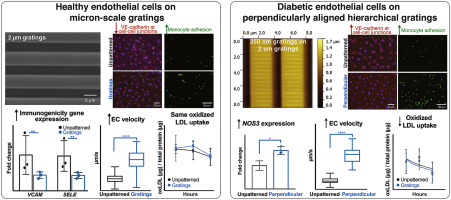当前位置:
X-MOL 学术
›
Biomaterials
›
论文详情
Our official English website, www.x-mol.net, welcomes your
feedback! (Note: you will need to create a separate account there.)
Functional differences between healthy and diabetic endothelial cells on topographical cues
Biomaterials ( IF 12.8 ) Pub Date : 2017-10-25 , DOI: 10.1016/j.biomaterials.2017.10.037 Marie F A Cutiongco 1 , Bryan M X Chua 2 , Dawn J H Neo 3 , Muhammad Rizwan 4 , Evelyn K F Yim 5
Biomaterials ( IF 12.8 ) Pub Date : 2017-10-25 , DOI: 10.1016/j.biomaterials.2017.10.037 Marie F A Cutiongco 1 , Bryan M X Chua 2 , Dawn J H Neo 3 , Muhammad Rizwan 4 , Evelyn K F Yim 5
Affiliation

|
The endothelial lining of blood vessels is severely affected in type II diabetes. Yet, there is still a paucity on the use of diabetic endothelial cells for study and assessment of implantable devices targeting vascular disease. This critically impairs our ability to determine appropriate topographical cues to be included in implantable devices that can be used to maintain or improve endothelial cell function in vivo. Here, the functional responses of healthy and diabetic human coronary arterial endothelial cells were studied and observed to differ depending on topography. Gratings (2 μm) maintained normal endothelial functions such as adhesiveness, angiogenic capacity and cell-cell junction formation, and reduced immunogenicity of healthy cells. However, a significant and consistent effect was not observed in diabetic cells. Instead, diabetic endothelial cells cultured on the perpendicularly aligned multi-scale hierarchical gratings (250 nm gratings on 2 μm gratings) drastically reduced the uptake of oxidized low-density lipoprotein, decreased immune activation, and accelerated cell migration. Concave microlens (1.8 μm diameter) topography were additionally observed to overwhelmingly deteriorate diabetic endothelial cell function. The results of this study support a new paradigm and approach in the design and testing of implantable devices and biomedical interventions for diabetic patients.
中文翻译:

健康和糖尿病内皮细胞在地形线索上的功能差异
II 型糖尿病患者的血管内皮层受到严重影响。然而,利用糖尿病内皮细胞来研究和评估针对血管疾病的植入装置的情况仍然很少。这严重损害了我们确定可用于维持或改善体内内皮细胞功能的可植入装置中包含的适当地形线索的能力。在这里,研究了健康和糖尿病人冠状动脉内皮细胞的功能反应,并观察到其功能反应因地形而异。光栅(2μm)维持正常的内皮功能,如粘附性、血管生成能力和细胞-细胞连接形成,并降低健康细胞的免疫原性。然而,在糖尿病细胞中并未观察到显着且一致的效果。相反,在垂直排列的多尺度分层光栅(2 μm 光栅上的 250 nm 光栅)上培养的糖尿病内皮细胞大大减少了氧化低密度脂蛋白的摄取,减少了免疫激活,并加速了细胞迁移。另外还观察到凹形微透镜(直径 1.8 μm)的形貌显着恶化糖尿病内皮细胞功能。这项研究的结果支持了糖尿病患者植入式设备和生物医学干预措施的设计和测试的新范例和方法。
更新日期:2017-10-25
中文翻译:

健康和糖尿病内皮细胞在地形线索上的功能差异
II 型糖尿病患者的血管内皮层受到严重影响。然而,利用糖尿病内皮细胞来研究和评估针对血管疾病的植入装置的情况仍然很少。这严重损害了我们确定可用于维持或改善体内内皮细胞功能的可植入装置中包含的适当地形线索的能力。在这里,研究了健康和糖尿病人冠状动脉内皮细胞的功能反应,并观察到其功能反应因地形而异。光栅(2μm)维持正常的内皮功能,如粘附性、血管生成能力和细胞-细胞连接形成,并降低健康细胞的免疫原性。然而,在糖尿病细胞中并未观察到显着且一致的效果。相反,在垂直排列的多尺度分层光栅(2 μm 光栅上的 250 nm 光栅)上培养的糖尿病内皮细胞大大减少了氧化低密度脂蛋白的摄取,减少了免疫激活,并加速了细胞迁移。另外还观察到凹形微透镜(直径 1.8 μm)的形貌显着恶化糖尿病内皮细胞功能。这项研究的结果支持了糖尿病患者植入式设备和生物医学干预措施的设计和测试的新范例和方法。











































 京公网安备 11010802027423号
京公网安备 11010802027423号